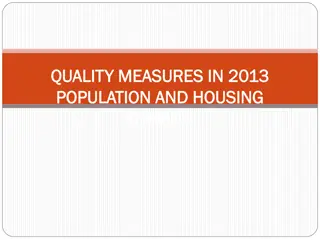Overview of the 2016 Lesotho Population and Housing Census
The 2016 Lesotho Population and Housing Census aimed to improve the lives of the nation through reliable data for planning, policy-making, service delivery, and evaluation of development programs. It involved counting all residents, including those in cattle-posts and institutions, with activities like designing a census logo, training cartography teams, and finalizing data collection tools.
Download Presentation

Please find below an Image/Link to download the presentation.
The content on the website is provided AS IS for your information and personal use only. It may not be sold, licensed, or shared on other websites without obtaining consent from the author.If you encounter any issues during the download, it is possible that the publisher has removed the file from their server.
You are allowed to download the files provided on this website for personal or commercial use, subject to the condition that they are used lawfully. All files are the property of their respective owners.
The content on the website is provided AS IS for your information and personal use only. It may not be sold, licensed, or shared on other websites without obtaining consent from the author.
E N D
Presentation Transcript
Goals of the 2016 PHC Scope of the 2016 PHC Built-up to Census Milestones Data Collection Census Data Processing Challenges Lessons Learnt
The goal of the 2016 Lesotho Population and Housing Census (PHC) is to contribute to the general improvement of lives of the Lesotho nation through the provision of most up-to- date and reliable planning, informed policy formulation, proper service delivery as well as monitoring and evaluation of population and projects data for development related programmes
The census is meant to provide information on the size, distribution and characteristics of a country s population. A basic administrative use is in the demarcation of constituencies representation to governing bodies. The census is also an invaluable resource for research, providing data for scientific analysis of the composition and population and for statistical models to forecast its future growth and allocation of distribution of the
2016 PHC involved a complete count of all persons including those in the cattle-posts and institutions The count covered the usual residents of Lesotho who were country at the time of the census (de facto count) as well as the usual members of households residing outside the country (de jure count). The 2016 PHC was undertaken on 10th APRIL 2016 found within the
Planning for a census involved identifying objectives/outputs, activities to be undertaken, timelines and required resources. The development of project document, displaying census objectives and strategies that are aligned with activities. Establishment of administrative/organisational structures such as census committees Development of cartographic/GIS mapping programme and implementing it. Development of Census Parliamentary Proclamation Development of census tools
PRE-CENSUS ACTIVITIES Census logo designed and approved in 2014. Project document finalised by experts assigned by the UNFPA in 2015. The cartography coordinating team trained on cartography and GIS applications in RSA in 2015. Geo-Space International (RSA) engaged to provide expertise in cartography and mapping exercise in 2015. Demarcation of Enumeration Areas (EA)s completed in August 2015. The census parliamentary proclamation endorsed and passed by the authorities legal notice number 59 of 2015. Census data collection tools finalized and approved by the Census Technical Committee in January 2016.
Data Processing Team trained on CSPro android application for 2016 PHC. The Data Processing Team developed and tested an application to be used for data collection. Census pilot conducted in October 2015. Pilot Feedback meeting held on the 19th October 2015 deliberations on the findings.
Recruitment requirements Enumerators 6000 (5776 for EA s and 224 for Institutions and cattleposts) Specs Diploma Holders in Social Science subjects Aged less or equal to 50 Should not be physically challenged Assistant Supervisors 1500 specs BA Degree holders in Social sciences (Demography, Statistics, Economics, Sociology etc) Aged less or equal to 50 & not physically challenged IT Coordinators 50 Specs Holding a degree in Computer science or honors degree in computer science Aged less or equal to 50
Transport Number of vehicles 100 government vehicles from other ministries 250 Privately hired vehicles Procurement All stationery, publicity materials (t- shirts, bags, caps, reflector vests, banners, adverts, etc), IT equipment etc. were procured on time.
5 October 2024 Training Schedule TOT (20) trainers plus (50) IT Coordinators February 2016. Level I training of Constituency Supervisors (300) in March, 2016. Level II training of 1 500 Area assistant Supervisors in March 2016. While Level III training was for Enumerators (approximately 6 000) in March April, 2016. 11
5 October 2024 Personnel IT Experts were based at Headquarters and districts. At Headquarters: Developers, mainly BoS staff who were assisted by temporary staff and an external expert (Consultant) in PDA application development and implementation. Database Administrators, mainly BoS IT staff, assisted by temporary staff and an external expert (Consultant). Network and Security Administrators, mainly BoS IT staff, assisted by temporary staff and an external expert (Consultant). Computer technicians and additional IT officers were engaged on temporary basis. At the field: IT Coordinators were deployed on temporary basis to assist Enumerators during data collection Supervisors for data transfer 12
5 October 2024 Use of servers at Headquarters Servers, housed at BoS HQ and accessed through internet services. Fixed computers with internet connectivity in each of the district offices An Internet Service Provider(ISP) was engaged throughout the data collection exercise for internet services. 13
Equipment and materials Delayed acquisition and delivery of equipment (tablets, power banks & solar chargers). This caused a problem of not being able to test the equipment before distributing to the training centres even to upload the application into the gadgets and assigning ID Codes for enumerators and supervisors. Training Training centres were not adequate in other areas and lacked the capacity to accommodate the number required to be trained hence additional training centres had to be sourced immediately and this delayed training.
In the field Devices malfunctioning- the application had a problem of hiding the data. That s when enumerating thinking that their data has been deleted. But eventually the application was remotely upgraded through the server. Some Enumerators swapped EA s with their friends without informing their supervisors hence this caused a serious problem since their tablets could not accept their ID Codes simply because they were in the wrong areas. Data Processing There was a problem of duplicates in the main data file because of the problem of Enumerators re-enumeration of households when they discovered that they do not see the data in their gadgets. enumerators started re-
Despite the good work that Cartography/GIS division did, time allocated for the work was not enough hence some EA s were still too big. Procurement of equipment (hand-held devices) should be done well in advance to allow ample time for uploading applications and the testing. The number of IT Controllers was not adequate enough to cover all Enumerators in case of need with a ratio of about 1:120 hence in future the number should be increased. Its important also to make provision for enough time between delivery time for equipment and commencement of work.
P.o Box 455 Maseru. 100 00266-22323852 (BOS) E-mail : census@bos.gov.ls Web site: http//www.bos.gov.ls























